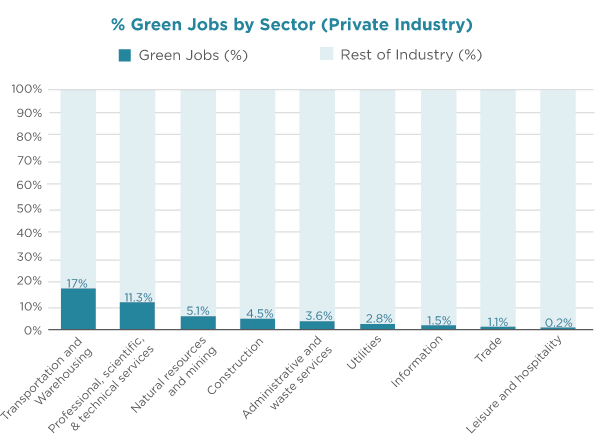According to a March 22, 2012 press release from the Bureau of Labor Statistics (BLS), in 2010 there were 3.1 million “green” jobs in the United States of which 15,583 were located in Hawaii. The number at first might seem to be low compared to other states. However, percentage wise the number of people employed in “green” jobs accounted for 2.7% of overall employment level, which is higher than the corresponding national level (2.4%).
Before describing how these jobs distribute across Hawai’i industry sectors it is important to note that the BLS has split their green job definition into two components/approaches: 1) an output-based approach (jobs associated with producing goods or providing services that benefit the environment or conserve natural resources), and 2) a process-based approach (jobs in which workers’ duties involve making their establishment’s production processes more environmentally friendly or use fewer natural resources). This release only includes the output-based approach, meaning that jobs which focus on education and training are not included, and the BLS expects to release the process-based jobs later this year.

Not surprisingly, the majority of green jobs, both nationwide and in Hawaii, are in the private sector. The highest number of private green jobs in Hawaii is reported to be in the transportation and warehousing industry: 3,932 jobs or 17% of total employment in that industry. Also a relatively high concentration of green jobs is observed among professional, scientific, and technical services (11.3%), natural resources and mining (5.1%), and construction (4.5%). Based on the ratio of green jobs to total jobs, the least green sectors are leisure and hospitality (0.2%) and trade (1.0%). Data for manufacturing, financial activities, and education/health services were not reported as it did not meet BLS disclosure standards.
One could expect an increase in jobs in the coming years associated with the Hawai’i Clean Energy Initiative, a statewide goal to achieve a 70% reduction in fossil fuel use by the year 2030. The initiative is driving policy development and funding towards renewable energy and energy efficiency. The State recently expanded its Renewable Portfolio Standard law (HRS § 269-91 et seq.) and passed an Energy Efficiency Portfolio Standard (HRS § 269-96 et seq.), requiring 40% of electricity generation to come from renewables and a 4,300 gigawatt hour reduction in electricity use by 2030, respectively. As the state ramps up to meet these obligations, presumably green job growth will occur.
In the past, there have been some challenges with quantifying the concept of green jobs since there was no clear consensus regarding what constitutes a green job. As defined by the BLS, green jobs are found in businesses that produce goods and provide services that benefit the environment or conserve natural resources. The Bureau lists five groups that green jobs fall into: (1) production of energy from renewable sources; (2) energy efficiency; (3) pollution reduction and removal, greenhouse gas reduction, and recycling and reuse; (4) natural resources conservation; and (5) environmental compliance, education and training, and public awareness. The data compiled by the BLS are collected through the Green Goods and Services survey which is based on approximately 120,000 establishments within 333 industries that are identified as potentially producing green goods or providing green services. It is important to recognize that not all jobs within these 333 industries are green: some of the industries may produce a mix of green and non-green goods or no green goods at all!
Hawaii’s Department of Labor and Industrial Relations (DLIR) launched its own “Hawaii Green Job Survey” that targeted more than 9,000 businesses statewide. The survey builds on the Hawaii Green Workforce Report. The DLIR’s definitions of “green” jobs, core green areas, and the total number of green jobs are somewhat similar to the BLS’s definitions. However, despite the similarities, the number of green jobs by industry reported in “2010 Hawaii’s Green Workforce: A Baseline Assessment” vary greatly. For example, the top three industries for green jobs are construction (the ratio of green jobs to total jobs equals 11%), administrative/support/waste management and remediation services (7%), and professional, scientific, and technical services (4%). Transportation and warehousing sector, on the other hand, had only 175 jobs compared to 3,932 jobs reported by the BLS. The discrepancies might be due to differences in the methodology; the DLIR did not separate their study into an output-based approach and a process-based approach. There will be an opportunity to better understand the discrepancies when the BLS releases the process-based numbers later this year.
– Inna Cintina